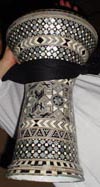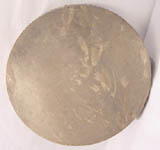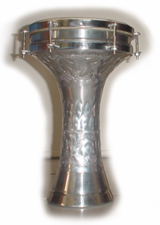
|
Amit Gilboa's World of
|
 |
| Shows | Press | Rhythm Writings | Services | Credentials | Booking | Home |

|
This is my standard performance darbuka. It has a nice sound and people really enjoy the intricate mother of pearl design. It is a modern design, meaning it has an aluminum body and vinyl head. |
 |
The riq used to be the star instrument of the Middle Eastern ensemble. It is played much more intricately than the Western tambourine Combining frame drum and finger cymbals, the riq can produce a wide array of exciting sounds and complex rhythms. | |
 |
The original materials of the darbuka were ceramic and fishskin. The natural materials create a softer tone, but the thinness of the fish skin still allows for sharp and precise sounds. | Called zils in Turkish or sagat in Arabic, the finger cymbals are a wonderful percussion instrument either played solo as demonstrated here or as an accompaniment to other percussion instruments. They are also often used by dancers as a musical accompaniment during their dances. | ||
 |
Another ceramic and skin darbuka, this one has a goatskin head. It has a much earthier sound than the others. I use it in collaboration with a pipa player. | These are my prized Saroyan-crafted Dervish zils, very heavy and with a distinctive gong-like sound. | ||
 |
This was the first darbuka I purchased. |  |
The bendir is an ancient Arabic frame drum. The head of the drum is held vertical and the drummer uses the fingers to produce the dums and taks. | |
|
|
This large modern darbuka provides a beautiful bass sound. |  |
This is a Turkish-style darbuka, meaning the tuning screws are level with the head | |
